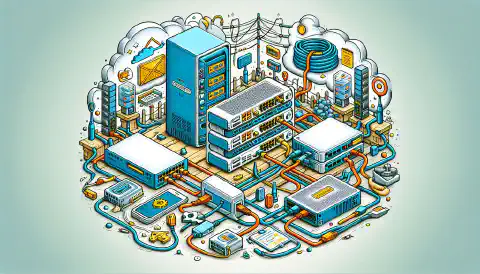Creating a Home Lab: A Guide for IT Professionals, Students, and Hobbyists

Table of Contents
A Home Lab is a personal laboratory setup that allows individuals to experiment, learn, and develop their skills in various areas of technology, including networking, virtualization, automation, and more. With the advent of affordable and powerful hardware, it has become easier than ever to create a Home Lab, providing you with a safe and controlled environment to test and play with new technologies.
Why Create a Home Lab?
There are many reasons why someone might want to create a Home Lab. For IT professionals, a Home Lab can provide a testing environment for new technologies, allowing them to experiment and develop their skills without the risk of breaking a production system. For students and hobbyists, a Home Lab can be an excellent learning tool, providing hands-on experience with real-world technologies and systems.
What Do You Need to Build a Home Lab?
Building a Home Lab requires a combination of hardware and software. The specific components you will need will depend on the goals of your Home Lab, but some common components include:
A computer or server to serve as the main host. This can be a powerful desktop computer or a dedicated server. For example, the Dell PowerEdge R740 is a popular choice for a Home Lab server.
Networking equipment, such as switches and routers, to create a network infrastructure within your Home Lab. For example, the Cisco Catalyst 2960 Series switches are commonly used in Home Lab setups.
Virtualization software, such as VMware or VirtualBox, to create virtual machines (VMs) on your main host. These software tools allow you to run multiple operating systems simultaneously. For example, VMware provides the popular VMware Workstation and VMware ESXi for virtualization.
Operating systems, such as Windows or Linux, to install on your virtual machines. These operating systems provide the foundation for running various applications and services in your Home Lab. For example, you can download the latest version of Ubuntu Linux for free.
Storage, such as hard drives or solid-state drives (SSDs), to store your virtual machine files and data. The storage capacity you need will depend on the size and number of virtual machines you plan to run. For example, the Samsung 860 EVO is a popular SSD choice for Home Lab enthusiasts.
Remember, these are just some examples of common components. The specific hardware and software you choose will depend on your budget, requirements, and personal preferences. Building a Home Lab is a flexible process that allows you to customize your setup according to your needs.
Setting Up Your Home Lab
Once you have all the necessary hardware and software components, you can start setting up your Home Lab. Here are some steps to get you started:
Choose a location: Choose a location for your Home Lab that has adequate power and internet connectivity. Ensure that the space you select can accommodate your hardware and networking equipment. It should also have a stable internet connection to facilitate communication and access to online resources.
Assemble your hardware: Assemble your hardware components, including your main host, networking equipment, and storage devices. Connect your server or computer, switches, routers, and storage devices together in a logical and organized manner. Make sure to follow the manufacturer’s instructions for proper installation and setup.
Install virtualization software: Install virtualization software on your main host. This software will allow you to run multiple virtual machines (VMs) on the same physical hardware. Popular virtualization platforms include VMware and VirtualBox. Follow the installation instructions provided by the respective software vendor to set up the virtualization environment.
Configure your network: Configure your networking equipment to provide internet connectivity to your VMs. Set up your switches, routers, and any additional networking components to create a secure and reliable network within your Home Lab. You can configure IP addresses, subnet masks, and other network settings based on your requirements.
Install operating systems: Install operating systems on your VMs, using the virtualization software. Choose the operating systems that align with your learning goals or specific projects. For example, you might want to install Windows Server for testing server applications or Ubuntu Linux for experimenting with open-source software. Ensure that you have the necessary installation media or ISO files to proceed with the operating system installations.
Start experimenting: Once your Home Lab is set up, it’s time to start experimenting. Install and configure various applications, services, and tools within your virtual machines. Explore different use cases, learn new technologies, and gain hands-on experience with real-world scenarios. Take advantage of the flexibility of your Home Lab to try out different configurations and test the limits of your systems.
Remember, these steps are just a starting point. You can customize and expand your Home Lab according to your interests and goals. Continuously explore new technologies, stay updated with industry trends, and leverage your Home Lab as a valuable learning resource.
Advanced Home Lab Topics
Once you have a basic Home Lab set up, you can start exploring more advanced topics. Here are some popular areas of focus:
Networking: Dive deeper into networking by studying and experimenting with different configurations. Explore concepts such as VLANs, VPNs, and firewalls. You can set up virtual networks, create VLAN trunks, establish secure VPN connections, and implement firewall rules to enhance network security and segmentation.
Virtualization: Take your Home Lab to the next level by experimenting with different virtualization platforms. Consider platforms like VMware ESXi, Microsoft Hyper-V, and Proxmox. These platforms provide powerful features for creating and managing virtual machines, allowing you to consolidate resources, create isolated environments, and optimize hardware utilization.
Automation: Streamline your Home Lab operations by automating various tasks and processes. Utilize popular automation tools like Ansible, Puppet, or Chef to configure and manage your Home Lab infrastructure. Automate the provisioning of virtual machines, deployment of applications, and configuration of networking components to save time and improve efficiency.
Storage: Explore different storage solutions to enhance data management in your Home Lab. Experiment with Network Attached Storage (NAS), Storage Area Networks (SANs), and Direct Attached Storage (DAS). Set up storage devices, create shared storage pools, configure RAID levels, and implement backup strategies to ensure data availability and protection.
Cloud Computing: Extend your Home Lab to the cloud by experimenting with cloud computing technologies. Dive into platforms such as Amazon Web Services (AWS), Microsoft Azure, and Google Cloud Platform. Learn how to provision virtual machines, create cloud storage buckets, and leverage various cloud services to understand the benefits and capabilities of cloud computing.
By exploring these advanced topics in your Home Lab, you can gain valuable hands-on experience, develop in-demand skills, and stay abreast of the latest trends in technology.
Best Practices for Home Lab
To ensure a smooth and efficient Home Lab experience, it’s important to follow these best practices:
Document your setup: Create comprehensive documentation of your Home Lab setup. This includes network diagrams, hardware specifications, and software versions. Documenting your setup helps you understand the overall architecture and assists in troubleshooting and future upgrades. Consider using tools like Microsoft Visio or draw.io to create detailed network diagrams.
Back up your data: Data protection is crucial in a Home Lab environment. Regularly back up your data to safeguard against hardware failures or accidental data loss. Set up automated backup processes using tools like Veeam Backup & Replication or rsync to ensure your important data is always protected.
Use a separate network: Isolating your Home Lab from your primary home network is essential to avoid potential security issues and conflicts. Create a separate network segment for your Home Lab using virtual LANs (VLANs) or physical network separation. This ensures that any lab-related activities or misconfigurations do not impact your main network’s stability or security.
Stay organized: Keeping your Home Lab organized and tidy is key to efficient management and troubleshooting. Label your physical equipment, neatly arrange cables, and maintain an orderly workspace. Adopt a consistent naming convention for virtual machines and network devices. This helps identify and resolve issues quickly, reducing downtime.
By following these best practices, you can maintain a well-documented, secure, and organized Home Lab environment that enhances your learning and experimentation.
Conclusion
A Home Lab is an invaluable resource for IT professionals, students, and technology enthusiasts seeking to expand their skills and knowledge. It offers a secure and controlled environment for learning, experimentation, and skill development. By following best practices, exploring advanced topics, and staying organized, you can unlock the full potential of your Home Lab.
Whether you’re an aspiring network engineer, a system administrator, or a passionate hobbyist, a Home Lab empowers you to gain hands-on experience with real-world technologies and systems. It allows you to test and validate new technologies without the risk of impacting production systems.
Investing time and effort into building and maintaining your Home Lab pays off in the long run. It becomes a playground for continuous learning, enabling you to stay updated with the latest industry trends and technologies. You can enhance your understanding of networking concepts, delve into the world of virtualization, automate tasks using powerful tools like Ansible or Puppet, and explore diverse storage and cloud computing solutions.
Remember to document your setup and back up your data to ensure you have a reliable reference and protect against potential failures. Use a separate network to maintain the security and stability of your Home Lab. Keeping your lab organized fosters efficiency and facilitates troubleshooting when issues arise.
Embark on your Home Lab journey today and take advantage of the endless possibilities it offers. Unleash your creativity, fuel your curiosity, and continuously push the boundaries of your technological expertise.






